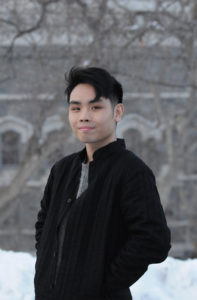Blink and you will miss it.

Minh Le
Whether it be between the hallways that students walk through, underneath the fluorescent light of studying hubs, or a bus ride away at Mountaintop, art resides everywhere on Lehigh’s campus.
Lurking around the fourth and fifth floors of E.W. Fairchild-Martindale Library, “Pedro Meyer: Truth From Fiction” is an encomium. Nothing is what it seems with the works of Meyer, who is a Mexican photographer and a pioneer in the digital revolution of contemporary photography.
Digitally manipulated or not, his photographs create alternative realities in which visual delirium and emotional stipulation trump veracity. All of Meyer’s photographs are equally true and untrue, and I find that prism to be rather impressionistic with the impact relying less on what you see and more on what you feel.
There are whimsical, almost dream-like, variables, like a photograph capturing that very moment when people are constantly pouring from all directions and trying to hustle through the crowd. In the middle of that frantic quandary, the silhouette of a horse, tethered by leather halters, spill from the side of a woman’s fur coat onto a glimmer where the sun filters through the superstructures of the city. In black and white, it is frivolous and surreal — a snapshot so illusory it could evaporate into thin air, yet so striking it could blow you away.
That incongruous contrast between nature and mankind seems to also be rendered in Meyer’s more politically charged artworks. A black and white photograph reveals a billboard for Caesars Entertainment with its gladiator shtick looming over the hunched backs of Mexican workers on a field.
By the same token, a native elder is depicted apprehensive as a behemoth of sorts roam through a piece of barren, desolate land in a photograph titled, “The Arrival of White Man.”
From my perspective, the sheer size of the Caucasian figure speaks just as much volume about the power of colonization as its plastic appearance bares about the environmental toll of urbanization. By no means does the superimposition look realistic, and yet that jarring quality cogently questions and subverts the affinity and belonging of humans in the natural world.
My first introduction to “Truth From Fiction” was “The Two X” — a photograph from a casual eatery digitally modified to a point where streaks of colors begin to dissolve and homogenize, as if they were captured through the eyes on a fleeting instant. I was intrigued even more, however, by the location of the artwork, just a few inches away from the touch of the viewers.
“We are a museum without walls,” said Mark Wonsidler, Lehigh University Art Galleries curatorial associate for exhibitions, collections and publications. “We are really interested in a situation where the museum comes to the viewer as opposed to the viewer necessarily coming to the museum.”
Indeed, these artworks do not pretend to be precious, and they are not here to be seen. Whether you are having your head buried in a book, typing away on your laptop or chatting up a storm, these artworks will inspire a sense of escape and imagination in those who choose to see them.





Comment policy
Comments posted to The Brown and White website are reviewed by a moderator before being approved. Incendiary speech or harassing language, including comments targeted at individuals, may be deemed unacceptable and not published. Spam and other soliciting will also be declined.
The Brown and White also reserves the right to not publish entirely anonymous comments.